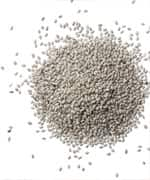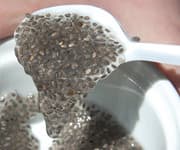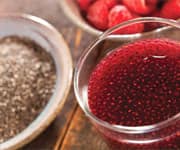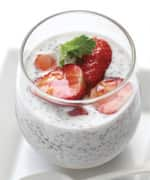Life Extension Magazine®

Recent studies have revealed that chia (Salvia hispanica) is a remarkably well-rounded nutritional source, providing protein, magnesium, phosphorus, and essential fatty acids. It is also the richest vegan source of omega-3 and dietary fiber. Gluten-free and grain-free, chia also has six times the calcium of milk.1
Chia—which is Mayan for “strength”—is a desert plant native to Central America with edible seeds that have a pleasing, nutty flavor. A relative of the mint family, these little black and white seeds were once a staple of the ancient Aztec diet.2
Now, a growing body of research points to chia’s power to help prevent diseases such as cardiovascular disorders,3,4 cancer,5 and diabetes.4 But above all, experts now recognize the remarkable weight-reducing capacity of chia seeds,6,7 which are often referred to as “a dieter’s dream.”

Lose Weight Without Starving
Hunger is a main enemy of weight loss. But tiny chia seeds quickly absorb a lot of liquid to create a gel8 that can keep you feeling full for hours. (This sticky gelatinous coating is how the seeds bonded to the popular terra cotta Chia Pets, which appear to grow hair overnight when watered.) When chia is exposed to water in the stomach, it increases in size and weight, and since the gel is made almost completely of water, it contains practically no calories. Since the gel coating continues to adhere tightly to each seed, it tricks the stomach into thinking it is full on just a fraction of the calories.9 Scientists have shown that chia decreases appetite for a full two hours after consumption and reduces the sugar spikes that occur after a meal.6 Because it absorbs 12 times its own weight, adding two tablespoons of chia to your diet reduces the energy density of food, while boosting fiber intake.9
Chia seeds are an excellent source of fiber, with 10 grams in two tablespoons—more than one-third of the daily recommended fiber intake. 10 Both the chia gel and fiber content help food move through your digestive tract faster—removing toxins from the body more quickly to help prevent constipation, diarrhea, and diverticulosis.11
In a randomized clinical trial, volunteers with metabolic syndrome consumed a beverage containing chia. After two months, those who consumed the chia had a greater decrease in body weight than controls, as well as an increase in adiponectin7—a hormone that plays a role in preventing obesity, metabolic syndrome, and type II diabetes.12-14 Adiponectin also exerts weight-loss effects on the body via the brain, similar to leptin, the satiety hormone.15 In this study, only the group consuming the chia beverage experienced decreases in serum triglycerides, in the inflammation marker C-reactive protein (CRP), and in the blood glucose response curve (AUC) after a glucose tolerance test.7
As an added bonus, Chia’s gelling action helps prolong hydration and retain electrolytes during exercise.
Easy Egg And Butter Replacement
 |
The tendency of chia to gel allows it to be used as an egg substitute in foods and baked goods, reducing dietary cholesterol and increasing nutrient content—as well as slashing calories. As a substitute for eggs, chia reduces calories and fat content, while not affecting taste, texture, color, or overall acceptability.25
To use as an egg replacement, simply mix one tablespoon of chia seeds with three tablespoons of water and let sit for 15 minutes.
Similarly, chia gel can replace half the butter in most recipes, since it bakes and and tastes the same or better. Simply divide the amount of butter called for in a recipe in half and make up the balance with chia.
Inhibiting Diabetes
More than 29 million Americans now have diabetes and nearly 86 million have prediabetes, a condition of abnormally high blood sugar levels that falls just short of diagnosis for type II diabetes.16 Preclinical research suggests that chia supplementation can prevent the insulin resistance that leads to diabetes. In animals fed a sugar-rich diet, chia seeds were also shown to favorably modify blood lipid changes.4
If you eat high-starch or high-sugar foods, blood sugar is more likely to spike after meals, which can raise your risk of diabetes.17 Consuming chia with a meal can combat this by turning food into constant, steady blood-sugar energy, rather than a dangerous series of glucose ups and downs.
Chia gel creates a physical barrier between the carbohydrates you eat and the digestive enzymes that break them down into sugar. Chia’s high content of complete protein and its novel combination of soluble and insoluble fiber combine with the chia-gel barrier to slow down your body’s conversion of carbohydrates into blood sugar.8
 |
Ways To Use Chia
Chia seeds absorb the flavor of any liquid in which they are soaked, making for some interesting flavor combinations. For example, instead of water, try soaking chia in milk, vegetable juice, fruit juice, sauce, or nut milk. Add dry seeds to smoothies, granola, soups, sauces, or salads to lower calorie intake, boost nutritive value, and increase satiety.
Cardiovascular Support
Diabetes and its risk factors greatly increase the risk of cardiovascular disease. For those with type II diabetes, conventional medications and lifestyle changes alone often fail to significantly reduce the risk of heart disease.
Cutting-edge research has found that chia supplementation can provide enhanced cardiovascular protection specifically for diabetics. Vladimir Vuksan, PhD, of the Risk Factor Modification Center at the University of Toronto, Canada, has devoted significant resources to the study of chia’s beneficial effects on diabetics who are at risk for cardiovascular disease.3
In his most recent clinical trial, 20 adults with type II diabetes took supplements of either chia or wheat bran daily for three months. By the end of the study, the chia group saw significant improvement across a range of disease markers, including blood pressure and lipid profiles, as well as inflammatory and clotting factors. Systolic blood pressure in the chia group dropped by six points, while the wheat bran group’s blood pressure was unchanged. C-reactive protein and clotting factors were also markedly reduced in the chia group compared to the wheat bran group.3
Scientists found that, as a dietary fat source, chia could lower total cholesterol levels while increasing HDL cholesterol. They also found that when substituting chia seeds for other fat sources, such as corn oil, chia was able to prevent high triglyceride levels and reduce abdominal obesity. This was a result of chia’s high content of alpha linolenic acid (ALA), which is a precursor of omega-3 fatty acids.4
Chia’s rich content of fiber and phytochemicals, along with its unparalleled abundance of omega-3 fatty acids—the greatest omega-3 source of any plant—strongly promotes heart and cholesterol health. Along with its plentiful omega-6 fatty acids, the omega-3s in chia help build new cells and regulate body processes.2,3,10,18
Chia seeds contain a high proportion of the daily recommended intakes of calcium, magnesium and especially, manganese1,10—nutrients that may help prevent hypertension.19,20 These minerals are also important for healthy weight, energy metabolism, and DNA synthesis.
Osteoporosis Prevention
Many Americans are not getting nearly enough calcium, especially those who avoid dairy. This can cause osteoporosis, a disorder that decreases bone density and increases risk of fractures. Osteoporosis afflicts 54 million American adults,21 80% of whom are women. Millions more have osteopenia, a condition that is essentially pre-osteoporosis.21 By 2020, half of all Americans over age 50 will be at risk.21,22
Fortunately, a single ounce of chia seeds provides 18% of your daily calcium requirement—six times as much as an equal quantity of milk!1
Cancer Protection
Chia has shown additional promise in cancer prevention. In a pre-clinical study involving breast cancer models, researchers found that dietary chia inhibited both the overall growth and the spread of cancer.5
Chia’s Shelf Life
Chia contains properties that help combat premature aging of the skin and inflammation of various tissues.23,24 These same properties allow raw chia seeds to stay fresh and ready to eat for about four years, without deterioration in flavor, odor, or nutritional value—a quality not found in many seeds. Prepared chia gel will keep for up to two weeks, and can keep any food tasting fresh longer if the gel is mixed into it during preparation.
Nutritional Content Of Chia
The abundance of fiber and essential fatty acids in chia packs a powerful nutritional wallop for minimal calories. A single ounce delivers 40% of your daily fiber requirement. Chia is the greatest source of omega-3 essential fatty acids of any plant food and provides high amounts of protein, calcium, phosphorus, and potassium.10
One ounce (or 28 grams) of dried chia seeds provides the following:10
Percent Daily Value
 |
|
Calories |
137 |
|
|
Calories from fat |
72.1 |
|
|
Calories from protein |
15.2 |
|
|
Saturated fat |
0.9 g |
4% |
|
Cholesterol |
0.0 g |
0% |
|
Dietary fiber |
10.6 g |
42% |
|
Protein |
4.4 g |
9% |
|
Sodium |
5.3 mg |
0% |
|
Calcium |
177 mg |
18% |
|
Potassium |
44.8 mg |
1% |
|
Phosphorus |
265 mg |
27% |
|
Manganese |
0.6 mg |
30% |
|
Zinc |
1.0 mg |
7% |
|
Total Omega-3 fatty acids |
4,915 mg |
|
|
Total Omega-6 fatty acids |
1,620 mg |
Summary
Growing research has shown the tiny Chia seeds to be a powerhouse that can help prevent diseases such as cardiovascular disorders, cancer, osteoporosis, and diabetes. But more importantly, it is recognized as “a dieter’s dream food” for its remarkable weight-loss capacity. Absorbing 12 times its own weight in liquids, studies have shown that chia decreases appetite for a full two hours after consumption, while reducing after-meal sugar spikes and providing 5 grams of fiber per tablespoon.
If you have any questions on the scientific content of this article, please call a Life Extension® Health Advisor at 1-866-864-3027.
References
- Available at: http://skipthepie.org/nut-and-seed-products/seeds-chia-seeds-dried/compared-to/milk-low-sodium-fluid/#minerals. Accessed June 25, 2014.
- Mohd Ali N, Yeap SK, Ho WY, Beh BK, Tan SW, Tan SG. The promising future of chia, Salvia hispanica L. J Biomed Biotechnol. 2012;2012:171956.
- Vuksan V, Whitham D, Sievenpiper JL, et al. Supplementation of conventional therapy with the novel grain Salba (Salvia hispanica L.) improves major and emerging cardiovascular risk factors in type 2 diabetes: results of a randomized controlled trial. Diabetes Care. 2007 Nov;30(11):2804-10.
- Chicco AG, D’Alessandro ME, Hein GJ, Oliva ME, Lombardo YB. Dietary chia seed (Salvia hispanica L.) rich in alpha-linolenic acid improves adiposity and normalizes hypertriacylglycerolaemia and insulin resistance in dyslipaemic rats. Br J Nutr. 2009 Jan;101(1):41-50.
- Espada CE, Berra MA, Martinez MJ, Eynard AR, Pasqualini ME. Effect of Chia oil (Salvia hispanica L.) rich in omega-3 fatty acids on the eicosanoid release, apoptosis and T-lymphocyte tumor infiltration in a murine mammary gland adenocarcinoma. Prostaglandins Leukot Essent Fatty Acids. 2007 Jul;77(1):21-8.
- Vuksan V, Jenkins AL, Dias AG, et al. Reduction in postprandial glucose excursion and prolongation of satiety: possible explanation of the long-term effects of whole grain Salba (Salvia hispanica). Eur J Clin Nutr. 2010 Apr;64(4):436-8.
- Guevara-Cruz M, Tovar AR, Aguilar-Salinas CA, et al. A dietary pattern including nopal, chia seed, soy protein, and oat reduces serum triglycerides and glucose intolerance in patients with metabolic syndrome. J Nutr. 2012 Jan;142(1):64-9.
- Muñoz LA, Cobosa A, Diaza O, Aguilerab JM. Chia seeds: Microstructure, mucilage extraction and hydration. J Food Eng. 2012 Jan;108(1):216-24.
- Alfredo V, Gabriel R, Luis C, David B. Physicochemical properties of a fibrous fraction from chia (Salvia hispanica L.) LWT-Food Sci Technol. 2009;42(1):168-73.
- Available at: http://nutritiondata.self.com/facts/nut-and-seed-products/3061/2. Accessed June 25, 2014.
- Matrana MR, Margolin DA. Epidemiology and pathophysiology of diverticular disease. Clin Colon Rectal Surg. 2009;22:141-6.
- Díez JJ, Iglesias P. The role of the novel adipocyte-derived hormone adiponectin in human disease. Eur J Endocrinol. 2003 Mar;148(3):293-300.
- Renaldi O, Pramono B, Sinorita H, Purnomo LB, Asdie RH, Asdie AH. Hypoadiponectinemia: a risk factor for metabolic syndrome. Acta Med Indones. 2009 Jan;41(1):20-4.
- Ukkola O, Santaniemi M. Adiponectin: a link between excess adiposity and associated comorbidities? J Mol Med. 2002 Nov;80(11):696-702.
- Nedvídková J, Smitka K, Kopský V, Hainer V. Adiponectin, an adipocyte-derived protein. Physiol Res. 2005;54(2):133-40.
- Available at: http://www.diabetes.org/diabetes-basics/statistics/?loc=superfooter. Accessed June 25, 2014.
- Tappy L, Lê KA, Tran C, Paquot N. Fructose and metabolic diseases: new findings, new questions. Nutrition. 2010 Nov-Dec;26(11-12):1044-9.
- Oliva ME, Ferreira MR, Chicco A, Lombardo YB. Dietary salba (Salvia hispanica L) seed rich in -linolenic acid improves adipose tissue dysfunction and the altered skeletal muscle glucose and lipid metabolism in dyslipidemic insulin-resistant rats. Prostaglandins Leukot Essent Fatty Acids. 2013 Oct;89(5):279-89.
- Panhwar AH, Kazi TG, Afridi HI, Talpur FN, Arain S, Kazi N. Distribution of potassium, calcium, magnesium, and sodium levels in biological samples of Pakistani hypertensive patients and control subjects. Clin Lab. 2014;60(3):463-74.
- Choi MK1, Bae YJ. Relationship between dietary magnesium, manganese, and copper and metabolic syndrome risk in Korean adults: the Korea National Health and Nutrition Examination Survey (2007-2008). Biol Trace Elem Res. 2013 Dec;156(1-3):56-66.
- Available at: http://nof.org/articles/7.Accessed June 25, 2014.
- Office of the Surgeon General (US). Bone Health and Osteoporosis: A Report of the Surgeon General. Rockville, MD: Office of the Surgeon General; 2004.
- Reyes-Caudillo E, Tecante A, Valdivia-López MA. Dietary fibre content and antioxidant activity of phenolic compounds present in Mexican chia (Salvia hispanica L.) seeds. Food Chemistry. 2008 Mar;107(2):656-63.
- Ames BN, Shigenaga MK, Hagen TM. Oxidants, antioxidants, and the degenerative diseases of aging. Proc Natl Acad Sci U S A. 1993 Sep;90(17):7915-22.
- Borneo R, Aguirre A, León AE. Chia (Salvia hispanica L) gel can be used as egg or oil replacer in cake formulations. J Am Diet Assoc. 2010 Jun;110(6):946-9.

